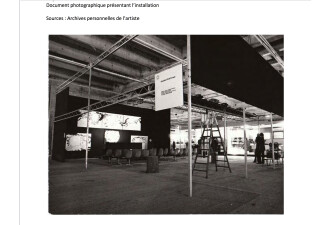Tableau-écran
In 1967, Fred Forest already had a rich past as a visual artist, producing drawings and paintings.
He had been the lead cartoonist for two national French newspapers: Combat and Les Echos. He feels that the plastic arts are too static. For him, the signature freezes the work in a definitive status, whereas he is looking for a form of work that renews itself.
1967 Tableau-écran
In 1967, Fred Forest already had a rich past as a visual artist, producing drawings and paintings. He had been the lead cartoonist for two national French newspapers: Combat and Les Echos. He has taken part in numerous exhibitions in Algiers, Les Andelys and Paris. He feels that the plastic arts are too static. For him, signatures freeze works in a definitive status, whereas he is looking for a form of work that renews itself. He was lucky enough to have a long conversation with Umberto Eco at the Frankfurt Book Fair, where the latter was manning the stand of his publisher Bompiani. He subsequently maintained a friendly relationship with him, with numerous telephone exchanges, and, for his screen painting, he converted to the notion of the "open work" advocated by the writer. Forest believes that signing a painting in some way kills it, because it freezes it in a single version and removes any possibility of development. So he conceived hybrid plastic works made of paint supports onto which he projected slides or super-eight films, developing ingenious systems that enabled him to obtain striking lighting effects, for which he filed a patent with the Institut National de la Propriété Industrielle that was never exploited. Working with the musician Luc Ferrari, he added sound, and they created two installations, the prototype of which was previewed in Paris at the Paul Facchetti gallery, before being installed in the Ivory Coast Pavilion at the Osaka World Fair in 1970. Based on a fiction imagined by Fred Forest with the help of photographer Patrice Libert, they produced more than 2,000 slides in the OSIRIS atomic pile at Saclay, which were never mounted. It's a chase between the musician and the painter, who, in this fantastic technological universe, never manage to get together...
1967 Tableau-écran 2
In 1967 Fred Forest, dissatisfied with painting whose immovably fixed forms no longer suited him, invented the Tableau-écran, for which he registered a patent with the Institut national de la propriété industrielle. This was a device that enabled him to project slides and super 8s onto painted pictures, with white spaces left to receive the light information that was superimposed on and completed the picture. He later added a tape recorder to add a sound dimension to his installation. At the first FIAC, held in the disused Bastille railway station in 1974, he and the musician Luc Ferrari presented the first official version in the context of contemporary art.
In 1970 he had already presented the Tableau-écran at the Salon de l'audiovisuel, publishing the following leaflet:
"What is a painter doing in the middle of a technical, industrial and commercial event?
He comes to find the sources of life.
He is trying to escape the sterilising system of art galleries. He escapes from the closed world where self-indulgent aesthetes cultivate absolute derision with the utmost refinement.
The true evolution of the arts is undoubtedly linked to the evolution of techniques, media and mores.
The world is changing its structures, and art is changing its language.
Art will also change its means, its audience and its location. The artist must therefore take the lead and go in search of these new places where he can organise his party.
.. I'm changing language
. You're changing language
He changes language
Audiovisual painting, light collage, show, animation?
With Tableau-écran I'm looking for a new language.
Fred Forest, Salon de l'audiovisuel, Paris, 1970".
This leaflet circulated in 1970 on the subject of the Tableau-écran by Fred Forest is indicative of the quasi-prophetic thinking of this artist whose practice throughout his life never ceased to belie his vision, which was in sync with the spirit of the times...





LONG BIOGRAPHY OF FRED FOREST
Fred Forest has a special place in contemporary art. Both by his personality and by his pioneering practices which mark his work. He is mainly known today for having used one by one most of the communication media that have appeared over the last fifty years. He is co-founder of three artistic movements: those of sociological art, the aesthetics of communication and ethics in art.
He represented France at the 12th São Paulo Biennale (Communication Prize) in 1973, at the 37th Venice Biennale in 1976 and at Documenta 6 in Kassel in 1977.
EXHIBITION AT THE CENTRE POMPIDOU FROM JANUARY 24 TO OCTOBER 14, 2024

















